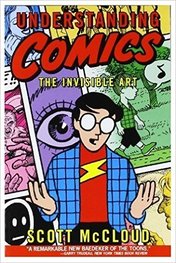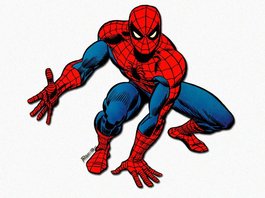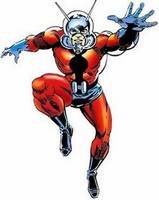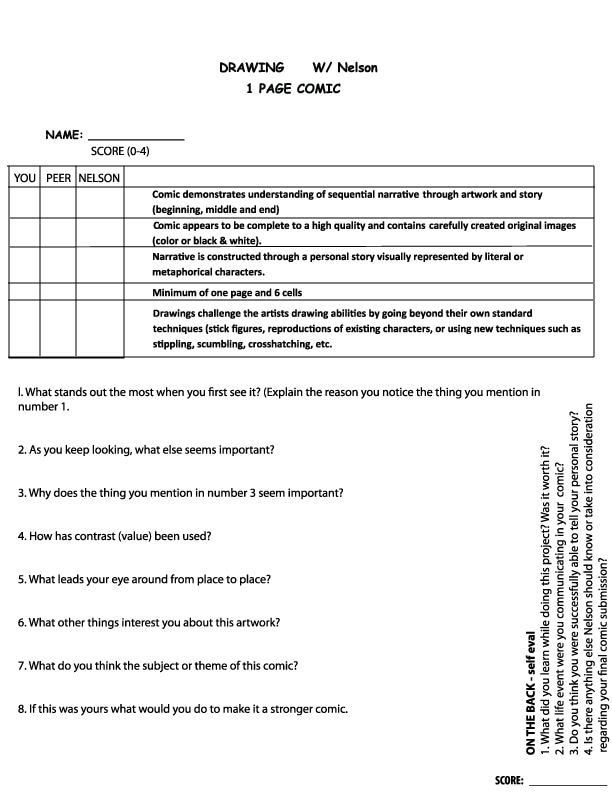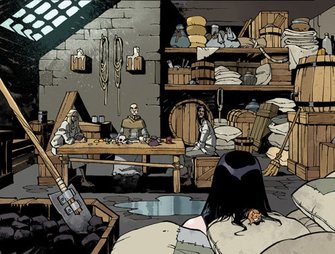GETTING STARTED...
|
Before we can really start creating comics we need to begin to understand them for what they really are. Scott McCloud's book Understanding Comics is a fantastic visual introduction to these big ideas. Pleas read chapters 1 & 2 by clicking on the book to the left and filling out the worksheet you were given in class. (if you misplaced the sheet there is a link below
| |||||||
COMIC VOCABULARY
Panel - Rectangles or squares where the action of the comic is drawn.
Symmetry - Having the same shape, size, and position on both sides of a dividing line.
Splash page- A panel that usually takes up the whole page, used to help introduce stories or give special attention to particular events
Word or Thought Bubbles - A bubble drawn to indicate dialogue, thoughts, sound or narration motion lines
Lines - in a comic to suggest movement body language Nonverbal communication through gestures, facial expressions, behaviors, and posture
Silhouette - An outline that appears dark against a light background sequence OR light against a dark background. This helps to provide contrast and make important images stand out
Motif - A unifying idea that is a recurrent element in a literary or artistic work
Shading - Graded markings that indicate light or shaded areas in a drawing or painting used to create the illusion of depth
Coloring - Use of color in a piece of art work
Inking - Applying black lines over the pencil drawings. This can be used to finish work if working in b&w
Lettering - Different font styles/sizes can be used to draw attention or emphasize words
Narrative - a report of related events presented to the listeners or readers in words arranged in a logical sequence. A story is taken as a synonym of narrative. A narrative or story is told by a narrator who may be a direct part of that experience and he or she often shares the experience as a first-person narrator. Sometimes he or she may only observe the events as a third-person narrator and gives his or her verdict.
Sequential Art - Images used to in a series or a an Arrangement in which things follow in logical order or a pattern portraying the passing of time.
Graphic Novel - A graphic novel can take a few different forms in the world of comic books. It is often a collection of previously printed comic book material that spans a story arc. There are also completely original graphic novels, referred to as OGN (original graphic novels). The graphic novels are usually either hardcover or have a softer cardboard cover that is still much thicker than regular comic book covers. They typically have near one hundred pages or more.
Shot - The framing of a panel. Long shot= full body or landscape, Medium Shot = Displaying item or characters from the waist up, Close up= typically focusing n on one essential image like a face or item
Gutter - Space between the panels
Panel - Rectangles or squares where the action of the comic is drawn.
Symmetry - Having the same shape, size, and position on both sides of a dividing line.
Splash page- A panel that usually takes up the whole page, used to help introduce stories or give special attention to particular events
Word or Thought Bubbles - A bubble drawn to indicate dialogue, thoughts, sound or narration motion lines
Lines - in a comic to suggest movement body language Nonverbal communication through gestures, facial expressions, behaviors, and posture
Silhouette - An outline that appears dark against a light background sequence OR light against a dark background. This helps to provide contrast and make important images stand out
Motif - A unifying idea that is a recurrent element in a literary or artistic work
Shading - Graded markings that indicate light or shaded areas in a drawing or painting used to create the illusion of depth
Coloring - Use of color in a piece of art work
Inking - Applying black lines over the pencil drawings. This can be used to finish work if working in b&w
Lettering - Different font styles/sizes can be used to draw attention or emphasize words
Narrative - a report of related events presented to the listeners or readers in words arranged in a logical sequence. A story is taken as a synonym of narrative. A narrative or story is told by a narrator who may be a direct part of that experience and he or she often shares the experience as a first-person narrator. Sometimes he or she may only observe the events as a third-person narrator and gives his or her verdict.
Sequential Art - Images used to in a series or a an Arrangement in which things follow in logical order or a pattern portraying the passing of time.
Graphic Novel - A graphic novel can take a few different forms in the world of comic books. It is often a collection of previously printed comic book material that spans a story arc. There are also completely original graphic novels, referred to as OGN (original graphic novels). The graphic novels are usually either hardcover or have a softer cardboard cover that is still much thicker than regular comic book covers. They typically have near one hundred pages or more.
Shot - The framing of a panel. Long shot= full body or landscape, Medium Shot = Displaying item or characters from the waist up, Close up= typically focusing n on one essential image like a face or item
Gutter - Space between the panels
CREATING A STORY
|
When it comes down to brass tacks dramatic archs is the skeleton of any good narrative; Cinderella, To Kill a Mocking Bird, Breaking Bad, etc. We are introduced to a character, something happens to cause change, struggles occur along the way to change, some type of change happens, a resolution occurs, and then we move on. In your comic you will be using this age old device to navigate your way through your story. REMEMBER!!!! A good story can carry poor drawings but a poor story can not be saved by amazing drawings.
Example: The movie water world from the tailor looks AMAZING! (at least it did in 1995). It had big name actors, amazing sets, and mindblowing special effects. The only problem was that the the plot was full of holes, extremely slow, and had essentially been done 10 years earlier in a movie called Mad Maxx. On the flip side the movie Blarr Witch Project cost $60,000 to make and Grossed almost $250 million dollars, which was almost 3 times more than the big budget Water World! |
|
If you are not sure were to start write about what you know... YOU! A comic can be about relationships, challenges, victories, adventures, or almost anything else. When you brainstorming remember that although it may be about you but, you can use metaphorical characters and exaggerated adventures to represent the true story.
THE RUBRIC
Below you will find the rubric that you will be graded upon. We will do this in class
